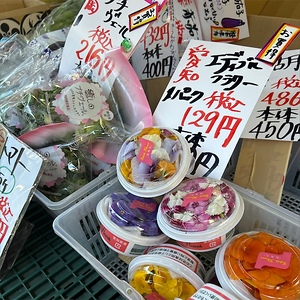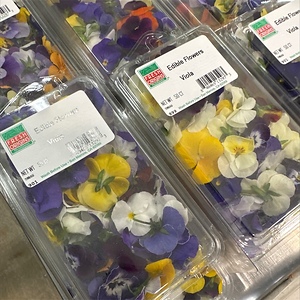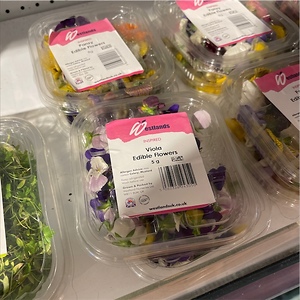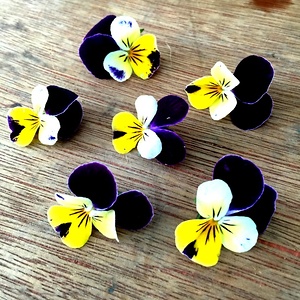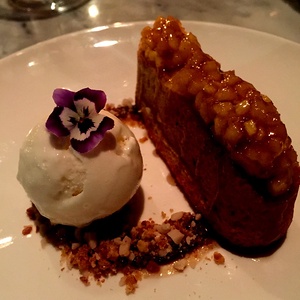

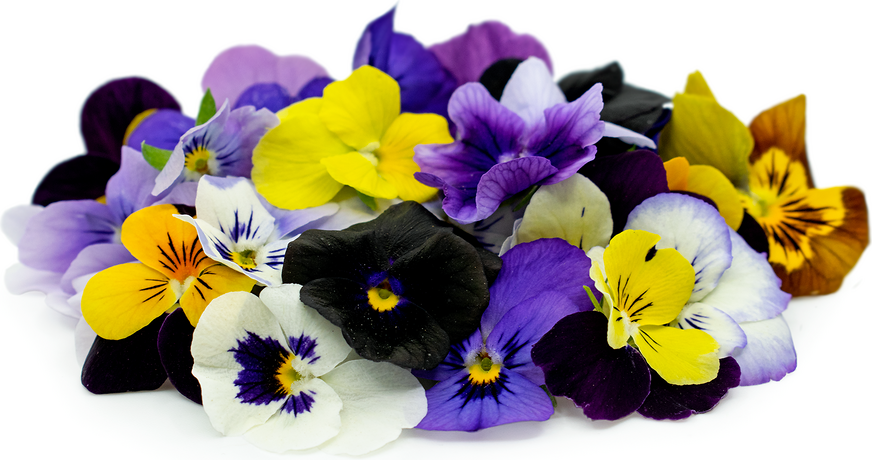
Viola Flowers
Estimated Inventory, 50 ct : 19.00
This item was last sold on : 07/26/25
| Fresh Origins | Homepage |
Description/Taste
Violas are small flowers that vary in color and shape, depending on the specific variety. Each flower consists of thin, delicate, and flat, curved petals with a soft, smooth, and silky consistency. The petals also differ in colors, some with solid hues of bright yellow, orange, royal purple, or maroon, while others display showy combinations of purple, white, and yellow with dark violet splashes of accent coloring and striping. Violas are unique as the entire flower is edible, and the blooms contain a crisp, succulent, and tender texture with a faint, perfumed scent. The colorful flowers also bear a subtly sweet, vegetal flavor with light mint and wintergreen nuances.
Seasons/Availability
Violas are available year-round.
Current Facts
Violas are small, edible flowers that are a part of a line of specialty blossoms grown by Fresh Origins Farm in San Diego, California. The delicate blooms can be used whole as a garnish and provide dishes with a subtle, sweet and vegetal flavor. Violas have been growing wild since ancient times, but Fresh Origins cultivates, hand selects, and develops a curated mix of colorful blooms to provide chefs with a unique, edible garnish to elevate the dining experience. Violas are considered one of Fresh Origin’s classic and favorite flowers, encasing a rich history while having a beautiful appearance and adapting to modern preparations. The colorful blooms can be incorporated into in-house meals, or they can be packaged as an added surprise in takeout orders to create a memorable dining experience. Violas can also be utilized in mixology to enhance the flavor and texture of beverages.
Nutritional Value
Violas are a source of vitamins A and C, nutrients with antioxidant-like properties to strengthen the immune system, boost collagen production within the skin, and defend the cells against damage inflicted by external environmental aggressors. The flowers also contain anthocyanins, pigments that give the petals their colored appearance and have anti-inflammatory and anti-bacterial properties to lower blood pressure and protect against disease.
Applications
Violas have a subtle flavor, delicate nature, and light scent that are showcased when added at the end of preparations to avoid wilting. The entire flower can be consumed and is a favored edible garnish, sprinkled over salads, soups, fruit bowls, dips, and soft cheeses, or strategically placed on pasta, seafood, sandwiches, appetizers, and other main dishes for added aesthetic. Violas can also be used to accent desserts such as cakes, scones, sorbets, crème brulee, cookies, puddings, and tarts, or they can be lightly cooked into syrups, jams, and jellies. When used for desserts, some chefs crystallize the flowers with egg whites and sugar to create a glistening, crisp consistency. Beyond culinary preparations, Violas are popular garnishes for cocktails, teas, and iced beverages. The flowers can also be frozen whole in ice cubes as a decorative element in drinks. Violas pair well with chocolate, apricots, mangoes, lemons, coconut, lavender, cinnamon, carrots, mushrooms, radish, asparagus, goat cheese, and meats such as poultry, turkey, and fish. Whole Viola flowers should be used immediately for the best quality and flower and will keep 2 to 6 days when stored in a sealed container in the refrigerator.
Ethnic/Cultural Info
Violets, a type of Viola belonging to the Viola genus, were historically the first flower associated with Valentine’s Day. St. Valentine was a priest thrown into prison by Claudius of Rome for marrying couples in secret. At the time, Claudius had outlawed marriage for young men who were eligible and of age to be soldiers. When St. Valentine was caught marrying couples against Claudius’s law, he was sentenced to death. Legend has it that St. Valentine gathered violets growing just outside his prison window and crushed them to create a dark ink. The saint used the ink to write loving letters from prison to encourage his family, friends, and acquaintances. It was also rumored that St. Valentine fell in love with the jailer’s daughter and would write her notes signing the letters “From Your Valentine.” St. Valentine was executed on February 14th, in 269 CE, which coincided with a pagan holiday known as Lupercalia, which honored the Roman goddess of love. Over time, as devotees remembered St. Valentine’s death, themes from the pagan holiday began intermixing with St. Valentine’s legend, creating the celebration that is recognized today. For many years, violets remained the primary flower given on Valentine’s Day in honor of St. Valentine, and couples would use St. Valentine’s signature, establishing “valentine” as a name for lovers during the holiday. In the early 1900s, it was very common to receive a box of candies paired with a bouquet of violets, and many receivers appreciated the flower’s heart-shaped appearance, believing it added to the holiday’s romantic spirit.
Geography/History
Violas are native to Europe and have been cultivated for thousands of years. The delicate flowers were widely used for medicinal applications in Ancient Greece, and in the Roman empire, the flowers were frequently made into wine. Violas continued to rise in popularity throughout the Victorian Era, where they were incorporated as edible garnishes, infused into perfumes, and used as a secret symbol to communicate feelings between lovers. Over time, the brightly colored blooms have remained a favorite culinary flower and continue to adapt to modern cooking methods. The Violas featured in the photograph above were cultivated at Fresh Origins Farm in San Diego, California, the leading American producer of naturally grown microgreens and edible flowers since the mid-1990s. Fresh Origins grows over 60 varieties of edible flowers and uses the mild and sunny Southern California climate year-round to produce flavorful, attractive, safe, and quality blooms. Fresh Origins also has the highest level third-party-audited food safety program and is a certified member of the California Leafy Greens Marketing Agreement, which follows science-based food safety practices to promote transparency and honesty in production. Violas sourced from Fresh Origins can be found through select distribution partners of Fresh Origins across the United States, including Specialty Produce, and are also found through partners in Canada.
Featured Restaurants
Restaurants currently purchasing this product as an ingredient for their menu.
| Alila Marea Beach Resort | Encinitas CA | 805-539-9719 |
| Temari-Zushi | San Diego CA | 858-345-0059 |
| Yoann Taboyan, Personal Chef | San Diego CA | 347-277-1958 |
| Harvest Kitchen | Vista CA | 619-709-0938 |
| 31ThirtyOne by Deckman | San Diego CA | 619-495-9814 |
| LANA | Solana Beach CA | 602-758-2596 |
| Manna | Encinitas CA | 510-366-3057 |
| Jeune Et Jolie | Carlsbad CA | 858-231-0862 |
| Fishery - Bar | San Diego CA | 858-272-9985 |
| 619 Spirits | San Diego CA | 509-701-9534 |
| Herb & Sea (Bar) | Encinitas CA | 858-587-6601 |
| Communion | San Diego CA | 619-606-5568 |
| The Holding Company | San Diego CA | 619-341-5898 |
| Trilogy Sanctuary | La Jolla CA | 858-633-3893 |
| Park 101 | Carlsbad CA | 760-434-2217 |
| Gata | La Jolla CA | 858-336-5550 |
| DS Catering Kitchen | Chula Vista CA | 619-703-9321 |
| Bella Beverage Catering & Events | San Diego CA | 619-501-5577 |
| Sago (Bar) | Encinitas CA | 858-382-4047 |
| Blue Ocean La Jolla | La Jolla CA | 858-999-0323 |
| A & M catering | San Diego CA | 206-802-8320 |
| JRDN Restaurant | San Diego CA | 858-270-5736 |
| Crudo Cevicheria & Oyster Bar | San Diego CA | 619-313-9127 |
| El Agave Restaurant & Tequileria | San Diego CA | 619-220-0692 |
| Juniper & Ivy | San Diego CA | 858-481-3666 |
| Dija Mara | Oceanside CA | 760-231-5376 |
| Estancia Adobe | San Diego CA | 858-550-1000 |
| Sycuan Casino | El Cajon CA | 619-445-6002 |
| Azuki Sushi Lounge | San Diego CA | 619-238-4760 |
| Inn at Rancho Santa Fe | Rancho Santa Fe CA | 858-381-8289 |
| Black Raill Kitchen + Bar | Carlsbad CA | 619-454-9182 |
| Hotel Republic San Diego | San Diego CA | 951-756-9357 |
| Kilowatt Brewing | Oceanside CA | 858-715-3998 |
| The Handmade Chef Meal Prep Co. | San Diego CA | 619-368-3705 |
| GelatoLove | Carlsbad CA | 760-297-0554 |
| Moniker Cocktail Co. | San Diego CA | 858-337-9716 |
| Giuseppe Restaurants & Fine Catering | San Diego CA | 619-436-7006 |
| Waverly | Cardiff CA | 619-244-0416 |
| Savory Moment (1) | Carlsbad CA | 619-633-8863 |
| Village Vino | San Diego CA | 619-546-8466 |
| Born & Raised | San Diego CA | 619-944-1631 |
| The Guild Hotel | San Diego CA | 619-764-5108 |
| Black Radish | San Diego CA | 619-775-7412 |
| Marriott Courtyard - Broadway | San Diego CA | 619-446-3008 |
| Webbcreationfood LLC | San Diego CA | 619-829-9194 |
| Hilton Garden Inn - Homewood Suites San Diego | San Diego CA | 619-696-6300 |
| Nolita Hall | San Diego CA | 619-618-8820 |
| Coast Catering | Escondido CA | 619-295-3173 |
| Nobu | San Diego CA | 619-814-4124 |
| Bridges at Rancho Santa Fe | Rancho Santa Fe CA | 858-759-6063 |
| Wormwood (Bar) | San Diego CA | 619-573-0289 |
| Claytons Bakery & Bistro | Coronado CA | 619-435-5425 |
| Parisien Gourmandises | La Jolla CA | 858-352-6552 |
| Virtue Coffee & Juice | San Diego CA | 619-485-0485 |
| Fairmont Grand Del Mar | San Diego CA | 858-314-1975 |
| Mission Bay Beach Club | San Diego CA | 858-201-7551 |
| Pendry SD (Lion Fish) | San Diego CA | 619-738-7000 |
| French Chef at Home | San Diego CA | 619-432-8051 |
| InterContinental Banquet Kitchen | San Diego CA | 619-501-9400 |
| Ju-Ichi | San Diego CA | 619-800-2203 |
| The Tavern Bar | Coronado CA | 602-628-5890 |
| Snake Oil Cocktail Company LLC | San Diego CA | 619-754-4041 |
| Park Hyatt Aviara | Carlsbad CA | 760-448-1234 |
Recipe Ideas
Recipes that include Viola Flowers. One




 Learn More...
Learn More...